In the warm air of an early-June morning, Jose Antonio Peña walks along a channel of gushing water in the Sierra Nevada of southern Spain. Traversing the rocky terrain and ducking beneath boughs of pine, he eventually reaches a grassy meadow on his left. The ancient artificial channel, known as an acequia, empties into the meadow, where its water branches into meandering streams that soak into the mountainside.
Throughout the spring thaw, Peña makes several trips a week from nearby Mecina-Bombarón – a whitewashed village on the southern slope of the mountain range – up a winding, potholed dirt road to monitor the acequia's level and flow, making adjustments as needed. The entire village depends on his actions – where the water flows now, in spring, determines where it will eventually end up when the summer comes.
For over a millennium, this acequia – from the Arabic as-saqiya, meaning "water conduit" or "water bearer" – has provided irrigation and drinking water to Mecina-Bombarón, enabling survival and agricultural prosperity in the semi-arid environment. The methods used by acequieros – people with expert skills in water catchment and allocation – to tend the channels today differ little from those used in the Middle Ages.
The channel is part of a 3,000km (1,800 mile) irrigation network built by the Moors across the Sierra Nevada between the 8th and 10th centuries. The Islamic water management techniques introduced from the east transformed the landscape and agriculture in what was then Al-Andalus. Acequias made life possible for agrarian communities, conserving and distributing scant and seasonal water resources throughout the rugged mountains. In the newly fertile conditions, the abundance of crops introduced by the Moors thrived, among them almonds, artichokes, chickpeas, aubergine (eggplant), lemons, pomegranates, spinach, quince, walnuts and watermelon.
While this ancient system is needed now more than ever, it's threatened like never before
Though ancient, this traditional water management system is sustainable, efficient and resilient. As climate change worsens, the network will become even more important for helping communities in the Sierra Nevada cope and equitably share an increasingly scarce and unpredictable resource.
While this ancient system is needed now more than ever, it's threatened like never before. As traditional irrigation systems struggle with a lack of profitability compared with intensive agriculture and the rural exodus continues, increasingly few people still hold the skills and knowledge required to maintain acequias.
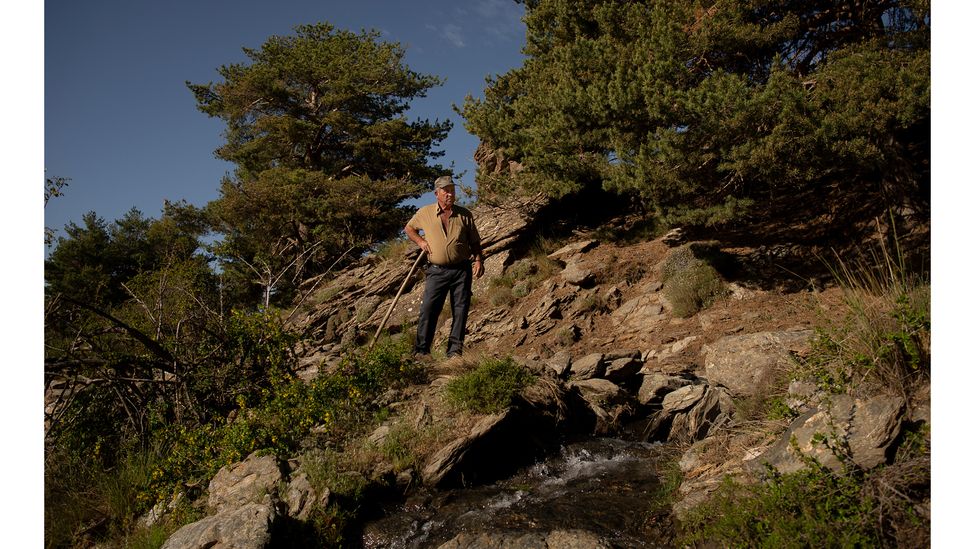
Jose Antonio Peña observes water as it's diverted from an acequia into a sima, part of a traditional system that provides water in the dry season (Credit: Kira Walker)
Each year, when the warmth of spring returns to the Sierra Nevada and the thaw begins, snowmelt is diverted from the headwaters of rivers into earthen, porous channels dug into the mountainside. As water flows through the gently descending acequias, ranging in length from tens of metres to kilometres, it's diverted to areas along the upper valley known as simas, where the channel empties and seeps into the ground, a process known as "sowing water". As water percolates through the subsoil, it replenishes aquifers and feeds springs and streams that emerge further down the mountain. The acequias of the Sierra Nevada are the oldest underground aquifer recharge system on the European continent, dating back more than 1,200 years.
Based on knowledge transmitted from generation to generation, acequieros like Peña understand the subterranean routes water takes. Where water is sown high in the valley determines where it eventually surfaces downslope, where it can be "harvested" to irrigate orchards, crops and gardens throughout the thirsty summer months. Without this system, most snowmelt and rain would flow quickly off the steep slopes as runoff in rivers. Sowing water slows the flow of water from the mountains, extending its availability for when it's most needed during the dry season.
Through research on sowing water, "we've found the river…has fewer peak flows and contains a more constant flow throughout the year," says Sergio Martos-Rosillo, a hydrogeologist at the Spanish Geological Survey. Research has also demonstrated how sowing water doubles the recharge of water in aquifers. The system follows the principles of ecohydrology, which uses "the regulating effect of vegetation, soil and aquifers, imitating nature to regulate water, instead of building concrete structures that alter the flow of water upstream and downstream", he says.
Water sowing and harvesting systems could be replicated in mountainous areas elsewhere in the world, where the geological and hydrological conditions are similar to those of the Sierra Nevada, Martos-Rosillo adds, noting there is interest in several Andean countries. In some areas, such systems already exist – one indigenous water management system developed independently in Peru around 1,400 years ago uses similar principles, which the government has been investing in to revive.
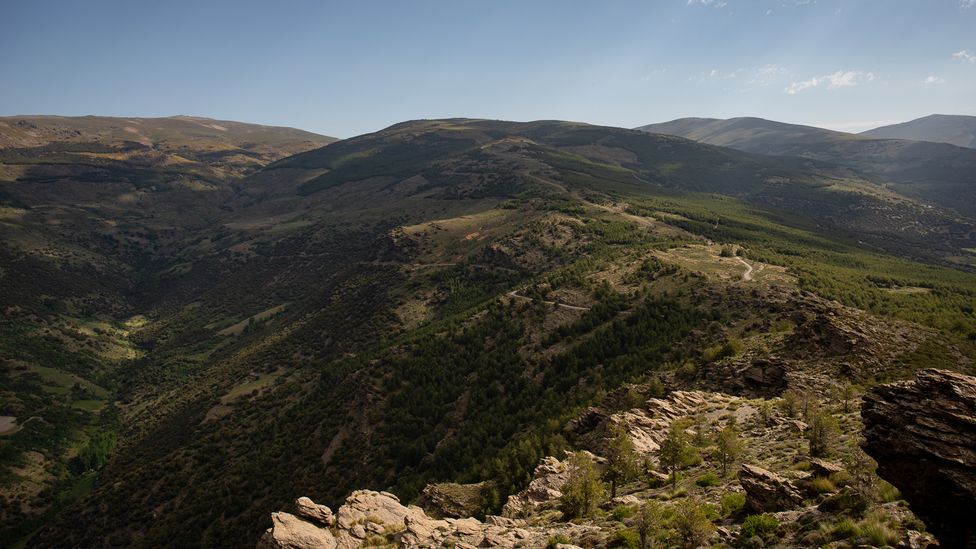
Snowmelt and rainfall runoff from the peaks of the Sierra Nevada is diverted into acequias, which channel water towards infiltration zones called simas (Credit: Kira Walker)
While the global potential of these water sowing techniques is perhaps underutilised, each area poses its own specific opportunities and challenges.
Standing in a sima, surrounded by rivulets of water, Peña, who became an acequiero three years ago and works in construction when not tending acequias, says he learned how the system works by accompanying his grandfather and uncle to the waterways as a young boy. Dressed in rubber boots and with a wooden hoe-like tool known locally as a leguna in hand, he nudges rocks and clears away grass, ensuring water flows unobstructed as it enters the sima. The work is repetitive and can be physically demanding. At nearly 10km (6 miles), with 15 simas spanning its length, the acequia providing Mecina-Bombarón with water is the largest in the Sierra Nevada.
Without these ancestral water channels, life as it now exists here would not be possible. No one knows this better than those who depend on the water, which is why the acequia in Mecina-Bombarón has been kept in continuous use for over a thousand years, having weathered many social, cultural, political and environmental changes. "The acequia is the life of the village. Without the acequias, all these villages would be a dryland, all these farms would be dry. It was very well planned," says Matilde Ruiz, who has lived her entire life in the village, standing in front of her garden planted with aubergine, lettuce, garlic and onions.
Water is normally sown until the end of June. But this year was far from normal. First, the snow came late, so it didn't freeze as solidly. Then, a heatwave arrived mid-May, accelerating the thaw. By early June, most snow had melted and water levels were low. And then another sweltering heatwave began mid-June. Peña says once-predictable weather patterns are gone: "Before, it snowed when it was supposed to snow, and the storms arrived when they were supposed to arrive." Now, neither snow nor rain behave as they used to, he says.
These shifts are a signal of what's to come in southern Spain, among Europe's driest and most climate-vulnerable regions. As summers become hotter and longer and winters milder and drier, learning how to cope with worsening water scarcity and prolonged droughts is taking on new urgency. Because acequias are resilient, efficient and a cost-effective way to provide water for communities and small-scale agriculture during the dry season, they're considered a vital tool to adapt to the region's changing climate.
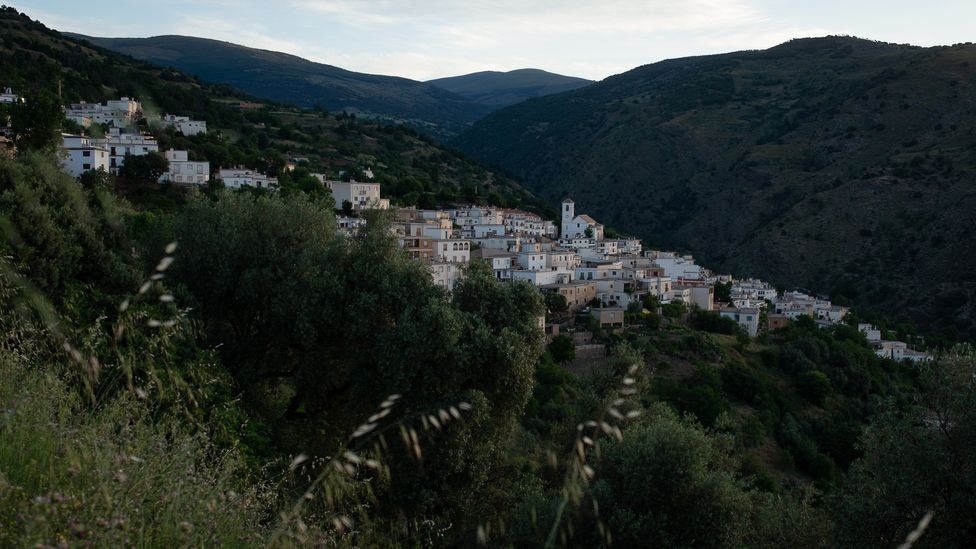
Since the channels were built over 1,000 years ago, acequias have sustained settlements like village of Mecina-Bombarón (Credit: Kira Walker)
When water sowing systems flow they provide numerous ecological benefits, too. Where such systems are used in Ecuador, biodiversity is higher than in areas where they haven't been implemented. In New Mexico, the channels function as ecological corridors, enhancing plant cover and diversity, which reduces soil erosion, and supporting wildlife habitat. In the Sierra Nevada, which also experiences the above benefits, irrigation made possible by acequias maintains pastures for grazing and supports crop diversity, bolstering local food security.
With the acequia, the life we have here is very different. They're magnificent – María José Estévez Villalba
In Spain as in Latin America, sowing water is a system of communal governance dependent on principles of equity, cooperation and trust. Water users share responsibility for maintaining and cleaning acequias, which favours social cohesion. Ensuring water is distributed fairly is just one of many challenges Peña must navigate in his role, which is as much about managing people as it is about managing water. "An acequiero has to be impartial, like a referee," he says.
In some villages, like Mecina-Bombarón, acequias have flowed continuously since the Middle Ages. Others were less fortunate. From the 1960s onwards, people began leaving the countryside in droves for cities across Spain and Europe in search of better lives. Widespread rural depopulation caused villages to fall into a state of decline, and many acequias – an estimated 15-20% of the Sierra Nevada's total – were abandoned and fell into disuse. When people left, with them went knowledge accrued over centuries.
To reverse this trend, a project established in 2014 by the Laboratory of Biocultural Archaeology at the University of Granada has been working to restore abandoned acequias and recover the flow of water, and traditional ecological knowledge, to villages across the Sierra Nevada. To date, the Memolab project has restored 14 acequias and cleaned 30 others. While the project's primary objective is to revive acequias, it's also a social intervention, says project coordinator José María Martín Civantos, an archaeology professor at the university. "We try to improve the governance of the community, to empower the community, to promote the dynamisation of the community and the recovery of knowledge and practices," he says.
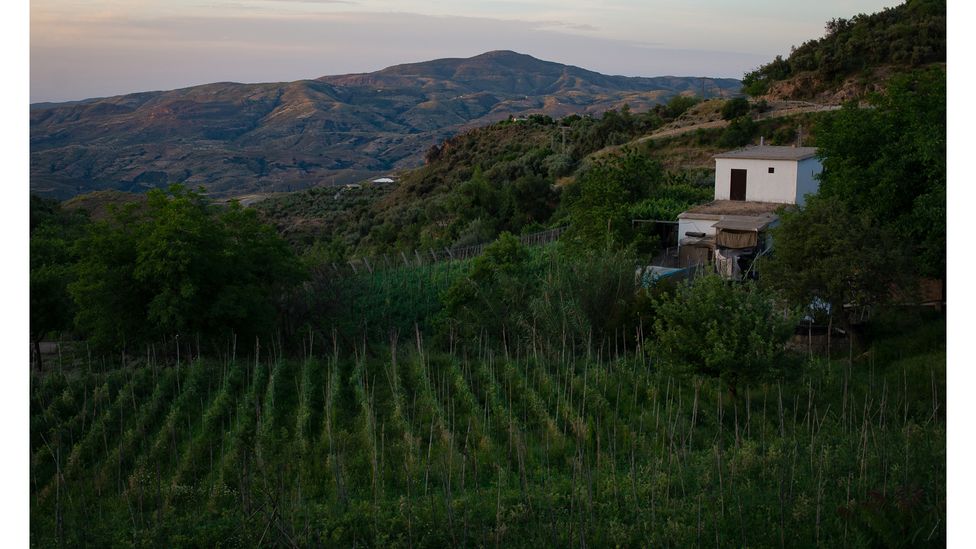
The practice of sowing water ensures its availability for irrigating crops, orchards and gardens throughout the dry season (Credit: Kira Walker)
The restoration projects are a way to provoke debate about agrarian and environmental policies, cultural heritage and values and address local tensions, says Civantos. "When there's an acequia that was abandoned 20, 30 or 40 years ago, you need to restore social distribution of water. That means you have to recover part of the knowledge and practices, and that also means conflict," he says. "But those conflicts are positive because that means the community is alive."
On the other side of the Sierra Nevada, in the village of Jérez del Marquesado, the benefits of restoration are tangible, says María José Estévez Villalba, secretary of the local irrigation community. "We compare villages next door [without acequias] that have drought, which we don't have. With the acequia, the life we have here is very different," she says. "They're magnificent. Whoever sees them, they understand."
With over 24,000km (15,000 miles) of acequias and 550 irrigation communities across the Andalusian provinces of Granada and Almeria, wider restoration could bring climate, environmental and social benefits to many. Yet despite their potential, acequias remain undervalued and getting support for further restoration is not easy, says Civantos.
The lack of support is related to the growth of high-tech, industrialised agriculture, Civantos says, as well as a lack of understanding of the acequias or their benefits. When efficiency is considered in terms of productivity, traditional agrarian systems, with their lower output, cannot compete with industrial agriculture. "But if we consider efficiency from a multifunctional perspective, traditional systems should be considered extremely efficient because they provide us with so many ecosystem services."

The practice of sowing and harvesting water can help communities adapt to climate change (Credit: Kira Walker)
According to Civantos, at the heart of the issue is how the rural world, and those who inhabit it, are often perceived. Lack of acknowledgement for agrarian activities and those who work the land, rooted in long-standing marginalisation and prejudice, pushes people towards other types of work that are better-regarded, he explains. Add in the low profitability of small-scale agriculture, making it near impossible to compete with the industrial model, and people, especially younger generations, have had enough. So they continue to leave.
Peña, who at 61 thinks he has only a few years left in him as an acequiero, is concerned the village's acequias will be abandoned. "That's why I'm here, because there aren't any young people. All these customs are being lost and young people don't want to know about it," he says. "They just put the glass under the tap, they don't know where the water comes from."
Carmen Aguilo, a fourth-year archaeology student at the University of Granada who has assisted several restoration and cleaning projects, thinks more awareness about acequias is needed if they are to survive. Starting in schools, she sees a need "to teach the values and the importance of water in general, as well as working with local people so that they understand this is also a heritage that has been bequeathed to them".
CARBON COUNT
The emissions from travel it took to report this story were 16kg CO2. The digital emissions from this story are an estimated 1.2g to 3.6g CO2 per page view. Find out more about how we calculated this figure here.
Ultimately, much of the acequias' fate rests with communities themselves. "At the end of the day we can go, we can help, we can start them up, we can clean them, but they're the ones who are going to have to take care of their maintenance and social organisation," says Aguilo. "In some places, they'll probably be very successful if the community gets involved. And in other places, if there's no involvement, they'll probably end up being lost. It's a shame."
Peña is pinning his hopes on children; reckoning that like him, exposure early on will help foster an appreciation for acequias that will translate into their preservation. In late May, he made a proposal to the municipal council to take children on excursions to see acequias and learn where their water comes from – a rich legacy they all share a stake in, but which they otherwise might not learn about. The mayor responded favourably, but the proposal has not yet moved forward.
Without sufficient people committed to preserving the acequias, this ancient system that has withstood so much may finally cease flowing. For Peña, it's a heartbreaking prospect. "The acequias are the most important thing we have in the village," he says. "If there's no water here, people can't live."
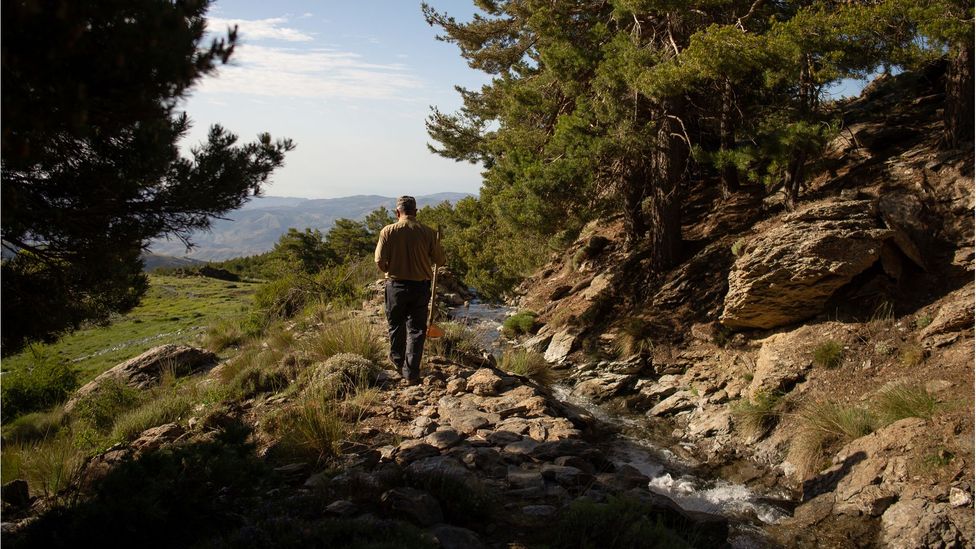

No comments:
Post a Comment